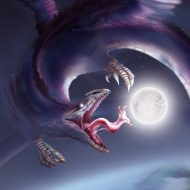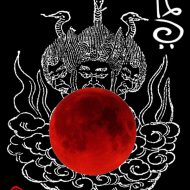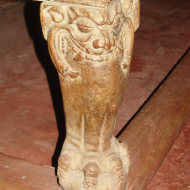Lawu : The Sun/Moon Eater
Listen
At a glance
| Description | |
|---|---|
| Origin | Philippine Mythology |
| Classification | Hybrids |
| Family Members | N/A |
| Region | Philippines |
| Associated With | Solar and Lunar Eclipse |
Lawu
Introduction
Within the intricate tapestry of Philippine mythology, Lawu emerges as one of the most captivating and enigmatic entities. Frequently portrayed as a monstrous deity possessed by an insatiable appetite for the sun and moon, Lawu has seized the imaginations of numerous generations, seamlessly intertwining the realms of the natural and the supernatural.
The legend of Lawu has been transmitted through the ages among Filipinos, and its various iterations have become integral parts of the diverse tapestry of Philippine folklore. Although numerous renditions of the tale exist, the fundamental narrative remains strikingly consistent.
Physical Traits
Lawu is a colossal creature that appears to be a fusion of a serpent, a bird, and certain crocodilian traits. It possesses sharp claws, formidable fangs, and a birdlike aspect with wings, accompanied by a menacing countenance reminiscent of a crocodile. While Lawu is most commonly referred to as male, it can also be depicted as female.
In the most prevalent version of the tale, Lawu is an immense, serpentine entity residing in the depths of the sea. This ancient being is said to possess the ability to stretch its massive form across the horizon and is infamous for its unquenchable appetite for celestial entities, specifically the sun and the moon. During times of darkness, when the world is cloaked in twilight, it is believed that Lawu has successfully consumed either of these celestial orbs.
Family
The tale of Lawu also highlights the rich imagination and creativity of the Kapampángan people. It serves as a reminder of the vibrant folklore that forms an integral part of Philippine culture. The Kapampángan homeland, known as Indûng Kapampángan, is situated in the northern region of Luzon in the Philippines. The Kapampángan language, affectionately referred to as Amánung Sísuan or ‘the language nurtured from the mother’s breast,’ is spoken by approximately 2 million people.
Other names
Throughout the Philippine archipelago, a recurring motif emerges — that of the sun/moon devourer, a mystical entity with an insatiable appetite for the sun or moon, capable of inducing solar and lunar eclipses. This motif is prevalent in various regions, featuring renowned characters like Bakunawa in the Visayas, Arimaonga among the Maranaos, Tambanakano in the Manfayas, Tambanakaua within the Manobos, Laho amid the Tagalogs, Sawa of the Ati in Panay, Kedu within the Maguindanaons, Olimaw in the Ilocanos’ lore, and Minokawa in the tales of the Bagobos, among a host of others.
Powers and Abilities
Lawu, renowned as the Sun/Moon Eater, is a motif that permeates the Philippine archipelago. This formidable entity, Lawu, is known for its ability to engulf the sun or moon, instigating solar or lunar eclipses. When Lawu engulfs the sun or moon entirely, resulting in a total eclipse, the people brace themselves for an impending famine. However, should the sun or moon muster the strength to rupture Lawu’s grasp and emerge partially (yielding a partial eclipse), the threat of famine is averted.
The journey to rescue the sun or moon unfolds as an epic saga, replete with heroic battles, ingenious tactics, and the conquering of myriad challenges. These tales impart invaluable lessons, underscoring the importance of unwavering resolve, collaboration, and the pursuit of a greater good. They also underscore the significance of confronting the formidable forces of darkness and disorder, regardless of the seemingly insurmountable odds.
In the majority of iterations of the Lawu myth, the valiant heroes eventually prevail in their quest to vanquish Lawu and restore the pilfered sun or moon to the heavens. This climactic moment symbolizes the triumph of light over darkness, the restoration of order amidst chaos, and the reinstatement of equilibrium in the natural world. The return of the celestial bodies is met with jubilant feasts, resounding music, and spirited dances, exemplifying the Filipinos’ deep-seated adoration for life and their profound reverence for the splendor and marvels of the natural world. The narrative of Lawu, with its cyclical pattern of threat, struggle, and ultimate victory, mirrors the recurring cycles of existence and the rekindling of hope with each new day.
Modern Day Influence
Lawu, the sun/moon eater of Philippine mythology, stands as a testament to the richness of Filipino folklore. It is a story that weaves together themes of balance, heroism, cosmic symbolism, and the enduring human spirit. The myth of Lawu continues to be a source of inspiration, reminding Filipinos of the importance of preserving the natural world, confronting darkness, and celebrating the triumph of light. In the heart of this narrative, Lawu remains an enigmatic and captivating figure that has left an indelible mark on the cultural fabric of the Philippines, where stories of the past continue to illuminate the present.
While Lawu may not have achieved the same level of recognition as some other mythological creatures, it possesses a unique and captivating narrative that could inspire a wide range of creative works in modern pop culture. Its story of struggle, heroism, and the triumph of light over darkness holds the potential for intriguing adaptations in various artistic forms.
Related Images
Frequently Asked Questions
What is lorem Ipsum?
I am text block. Click edit button to change this text. Lorem ipsum dolor sit amet, consectetur adipiscing elit. Ut elit tellus, luctus nec ullamcorper mattis, pulvinar dapibus leo.
What is lorem Ipsum?
I am text block. Click edit button to change this text. Lorem ipsum dolor sit amet, consectetur adipiscing elit. Ut elit tellus, luctus nec ullamcorper mattis, pulvinar dapibus leo.
What is lorem Ipsum?
I am text block. Click edit button to change this text. Lorem ipsum dolor sit amet, consectetur adipiscing elit. Ut elit tellus, luctus nec ullamcorper mattis, pulvinar dapibus leo.
What is lorem Ipsum?
I am text block. Click edit button to change this text. Lorem ipsum dolor sit amet, consectetur adipiscing elit. Ut elit tellus, luctus nec ullamcorper mattis, pulvinar dapibus leo.
What is lorem Ipsum?
I am text block. Click edit button to change this text. Lorem ipsum dolor sit amet, consectetur adipiscing elit. Ut elit tellus, luctus nec ullamcorper mattis, pulvinar dapibus leo.







